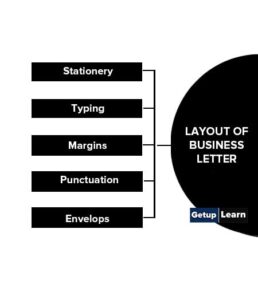Table of Contents
What is the purpose of letter writing?
One of the most important forms of non-verbal written communication is ‘Letter Writing’. An effective letter can do wonders. Verbal communication may or may not be as effective as a small letter. Right from the past centuries, letters had been drafted and used as authenticated means of communication in society. With the passage of time, the forms, styles, structure, purposes, presentation, and technology have brought significant changes in the art of letter writing.

In business organizations worldwide, people from different cultural beliefs work together for a common goal and letter binds them in unanimity of work culture. Any letter whether it is personal, official, or business reflects the personality traits of its writer. There are various principles and pre-requisites of effective letter writing.
Types of Letters
Correspondence is one of the chief means of keeping oneself in touch with those separated by distance. Despite the availability of modem means of quick and convenient ways of transmitting human sound, letters are as important today as they were centuries ago.
With the growth of commerce and industry, their use has increased. Business communicators have identified a number of factors that one has to bear in mind in writing letters. Over the years these have crystallized into a set of principles that can enable a person to write successful letters. Before we discuss these principles, let us briefly look at the basic types of letters:
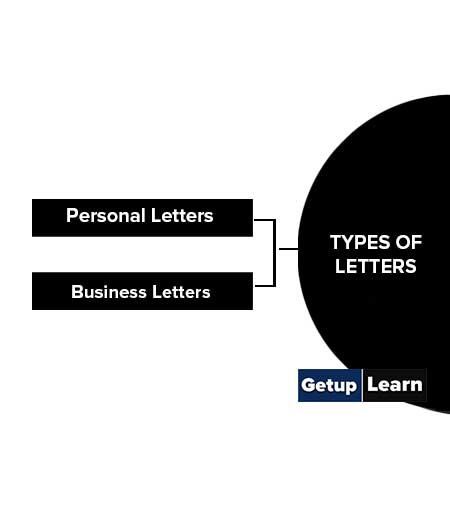
Personal Letters
If we think for a while, we will recall that we started ‘conversing’ with our mends and relations ‘by post’ at a very young age. And we will continue to write letters throughout our life. Such letters are called personal letters.
The object of a letter of this type is to establish a personal contact or to keep alive a personal relationship. It is a means of contact between us and our reader and has a certain intimacy, even ‘privacy’ about it. A personal letter must, therefore, evoke in the reader the sensation of an actual meeting.
It must be frank and intimate, lively and interesting, and should be written in an informal style. Formality has no place in personal letters we should not write to our friend or relative as though he or she were an audience we are addressing.
Reflects Personality
Every letter we write bears the hallmark of our character and personality. As we go through the following very brief correspondence between Ram and Lakhan, we will discover how their personalities are reflected in it. Both letters reflect politeness, simplicity, and a sense of humor. Ram must have felt amused to read exactly the same words which he had “written.
Mark also how politely Lakhan indicates that his name was not spelled correctly. Another thing to note is the simple manner in which both have shaken off the sense of ‘guilt’ that must have weighed upon their minds because of their behavior that night towards each other.
| Dear Professor Vikash I am sorry about last night when I sat next to you and did not say a word. You must have thought I was a very rude man; I am really a very shy man. Sincerely yours Suraj |
Professor Vikash Replied
| Dear Sir Suraj I am sorry about last night when I sat next to you and did not say a word. You must have thought I was a very rude man; I am really a very shy man. Sincerely yours Vikash [ P .S. And now you’ve made it worse, for you have spelled my name wrong.] |
Business Letters
When we enter a profession, we shall have to write dozens of letters every day as part of our routine work. Many of these will be written to persons we have never met and perhaps we can never hope to meet. We will be writing letters to other firms and companies, suppliers, customers, associate organizations, government officers, credit agencies, employees, etc. Such letters are called business letters.
Their aim is to achieve a definite purpose, such as selling a product, making an inquiry, seeking information or advice, mollifying the injured feelings of a customer, creating goodwill, etc. A business letter must therefore appeal to the reader’s interest and induce in him the proper mood.
To achieve this it should have the necessary built-in attraction. It should open the mind of the reader to the message. There is one sure way of doing it: place yourself in the position of your correspondent and anticipate his feelings and reactions. A good letter writer, after having written a letter, asks himself, ‘How would I react to this?’; ‘What would my feelings be if I received such “a letter?’ This test enables him to look at his letter from the reader’s point of view and make the necessary changes.
“If he (the person you are replying to) is rude, be especially courteous. If he is muddle-headed, be especially lucid. If he is pig-headed, be patient. If he is helpful, be appreciative. If he convicts you of a mistake, acknowledge it freely and even with gratitude”.
Much of the ill-will generated by unimaginative letters can be eliminated. The ability to adapt oneself to the reader’s point of view is the basic requirement of a good letter. Look at the following letter written by the Maintenance Engineer of a factory campus to a senior officer whom he knew personally and with whom he had good relations.
| Dear Sir, Some of the officers residing in your line have been complaining about the insufficient supply of water, especially, the water pressure. In an on-the-spot survey, it has been reported that you have installed a water tap at the ground level. This creates low water pressure in the adjacent houses. The management does not provide hydrants or additional taps, outside or inside a house. I am directed to inform you that the unauthorized connection may please be disconnected within three days of the receipt of this letter. In case of necessity, this department will be pleased to help you in disconnecting the water connection. If this is not done within the stipulated time, the department will be forced to disconnect the line. Looking at the present wafer scarcity, we hope, you will help us in supplying water to your neighbors as well who are greatly inconvenienced by insufficient water supply. Your cooperation is solicited. Yours Faithfully |
Now let us consider the reply that the officer gave.
There is a lot of truth in the Chinese proverb: In the midst of joy do not promise to give a man anything, in the midst of great anger do not answer a man’s letter. Does the above reply have any traces of the officer’s anger? What about “ without proper verification, you have accepted a report which is not true”?
Does it not, in effect, say that the engineer is inefficient as he accepts false reports? Then the sentence “Since you have been in the employment of this factory for about 20 years, I thought you may be aware of this fact”, implies that either the engineer has a bad memory or he is a great pre-tender, or he is ill-disposed towards the writer.
Obviously, Sir Gowers’ advice has not been followed in the reply letter, too. Now, we give below a reply in which an attempt has been made to keep the reader’s point of view in mind.
| Dear Sir, Thank you for your letter No. ….. of ….. I feel deeply pained that without proper verification you have accepted a report which is not true. The fact is that the additional water tap was installed by your department in this house 15 years ago for the convenience of a foreigner who was occupying it then. Since you have been in the employment of this factory for about 20 years, I thought you would be aware of this fact. Recently, we have met several times but you never mentioned the need for disconnecting this tap. I must assure you that I am equally eager that a proper supply of water is available to all members of the community. In fact, at a mere suggestion (even on the telephone) I would have let your men disconnect the tap. Please feel free to send them any time you like. With kind regards, Yours Sincerely |
| Dear Sir, Thank you for your letter No. ….. of ….. I am sorry you had to bother to write to me about the additional tap in my house. A ring or a word from you would have surely got a go-ahead signal from me. Please do send your men any time you like to disconnect this tap from the main line. Incidentally, this tap was installed by the Maintenance Department about 15 years ago for the convenience of a foreigner who was then occupying this house. With Kindest Regards, Yours Sincerely |
After having discussed the fundamentals, let us now turn our attention to the principles which can help you write effective business letters.
Principles of Business Letter
To convey any message effectively, the business letter writing needs the application of certain communication principles. They provide guidelines for the content and style of presentation. Following are the principles of business letter writing:
- Clarity and Coherence
- Consideration
- Brevity
- Courtesy and Friendliness
- Conciseness
- Correctness
- Completeness
- Originality
- Neatness
- Effectiveness
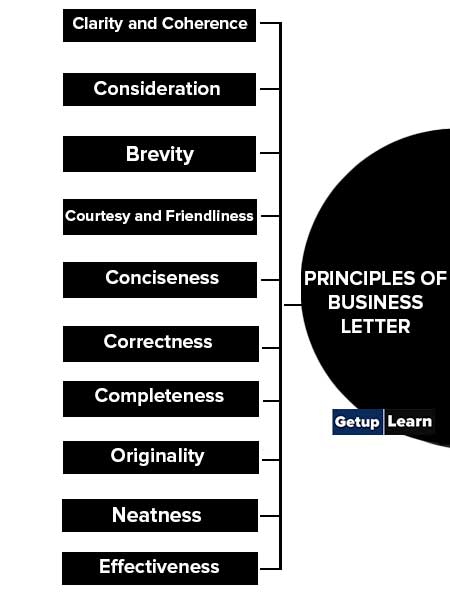
Clarity and Coherence
In order to be effective, a good business letter should be concise, precise, relevant, concrete, and consistent. Be clear about what you want to say and then say it clearly. Difficult words requiring the use of the dictionary, flowery expressions, and poetic language should be always avoided.
The words used should not be vague or ambiguous. The letter must convey to the recipient the exact meaning that the writer wants to communicate. The clarity of a letter, to a great extent, depends upon its unity or coherence.
Therefore, a letter should be written in a logical manner and reflect the consistency of thought. One thought should follow another in a proper sequence. An orderly arrangement of the subject is necessary and the same should be expressed in appropriate words. It is better to use short sentences and short paragraphs that are easier to read. “Send telegrams, not essays.”
Consideration
The writer of the letter should place himself in the position of the reader and give consideration as to what he needs. Emphasize “you-attitude” instead of “I-attitude”. Example: Improper: We sold 4000 dozens of handkerchiefs of this description last month. Proper: You and other businessmen like you bought 4000 dozens of handkerchiefs of this description in the last month.
Brevity
A good business letter should be concise and exact. The economy of words is possible only if the writer of the letter has extensive vocabulary at his command. A long letter containing irrelevant matter gives a poor impression of the writer and also of the business house.
But for the sake of conciseness, completeness or clarity should not be sacrificed. The letter must explain in full what it all desires. “Be conscious that the reader does not have much time”.
Courtesy and Friendliness
The tone of the business letter should always be courteous and polite. While drafting a business letter bluntness should never be regarded as a sign of strength. On the contrary, a poor image is bound to result from an offensive attitude conveyed through the letter. Courtesy is like oil which removes friction and creates goodwill. Courtesy should not be restricted to obligatory words like “Thank you” or “please”.
There must be politeness even in declining a proposal. Words like “please and “kindly” always bring a positive response. However such words ought to be used without sacrificing one’s self-respect and dignity.
Conciseness
A business letter should be concise and direct, written in simple language with a natural flow of words. Wordy phrases and high-flow expressions should be avoided. The letter should not contain quotations, or words which are pedantic (bookish) and which sound artificial. Business people are very busy and may be irritated by unnecessary lengthy letters. Therefore, one must focus directly on the message.
Correctness
A business letter should be grammatically correct and factually accurate. Incorrect information and inaccurate facts conveyed through a letter are bound to make the position of the writer vulnerable. The addressee may stop further dealings with the writer of the letter.
In letters of inquiry, orders, complaints, references, etc. information given should always be correct and exact. If for some reason, it is not possible to communicate the necessary information, the reason may be clearly stated in polite language.
Completeness
A business letter should include all the necessary facts and background information that supports the message being sent. An inquiry that does not contain necessary particulars or an explanation that is partial, is never appreciated.
An incomplete letter may compel the receiver to make further correspondence on the subject involving a waste of time or prompt him to act according to his own judgment which may lead to disputes.
Originality
The originality of form, expression, and style are often necessary to make business letters more appealing, particularly for sales promotion, and on special occasions, such as the introduction of a new product. Indeed, with changing times, old and stereo-typed forms and expressions have been replaced by more appealing forms, expressions, and styles of presentation of matters in business letters.
For instance, the layout of the contents of a letter is often intended to mark out significant lines. New phrases are used in place of old ones, and a conscious attempt is made to give a personal touch where necessary.
Neatness
A neat and tidy letter, clearly typed or written on a reasonably good paper with proper paragraphing makes a letter attractive to the reader. Any overwriting, rubbing or cutting of expressions, improper spacing between paragraphs, etc. do not create a favorable impression. So the appearance of a business letter should be impressive, neat, and tidy to the maximum extent possible.
Effectiveness
The ultimate goal of a business letter is the desired response in a positive manner within a reasonable time. Obviously, a delayed or negative response shows the ineffectiveness of the letter. The time and stationery used in writing such letters involve wasteful expenditure. Thus, effectiveness may be regarded as the most essential feature of a business letter.
Main Elements of Letter
To give a letter the right look, we should pay attention to its structure, layout, and form. The following main elements of letter:
- Heading
- Date
- Reference
- Inside Address
- Attention Line
- Salutation
- Subject
- Body
- Complimentary Close
- Signature
- Enclosure
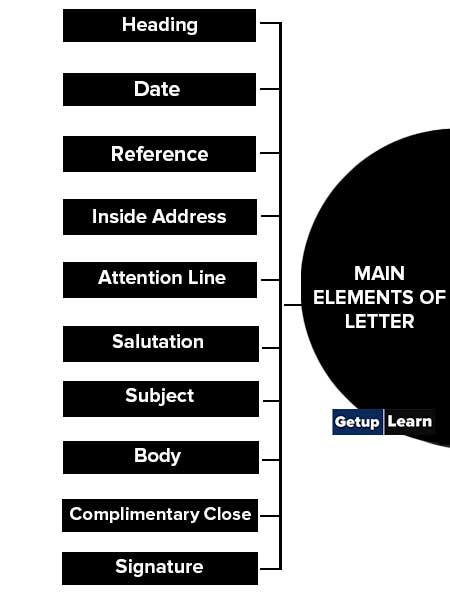
Heading

If a company is registered with limited liability, ‘Limited’ must be written after its name. Its registered address is also indicated on the letterhead.

Generally, the name and address are printed on the top middle of the page and any other information is indicated in the margins. To give a balanced appearance to the letter, a maximum of one-fifth of the total space should normally be used for the letterhead.
Date
Some letterheads contain a printed line indicating where the date should be typed, in others, the typist chooses the right place for it. It should be typed two spaces below the last line of the letterhead. The date, month, and year should be indicated in the upper right-hand comer as:
| D/MM/YY: 24th August, 20XX 2 August, 2022 August 2, 2022 |
Both methods are acceptable. One should follow the practice in vogue in one’s firm. But if you have a choice, perhaps the first method of indicating the date is preferable; it proceeds in the logical order of the day, month and year. The point to note is that the names of the month and the year are written in full and no suffix and as ‘nd’ or ‘th’ (2nd or 15th) is added to the day.
Reference
Some letterheads have two lines to indicate references:
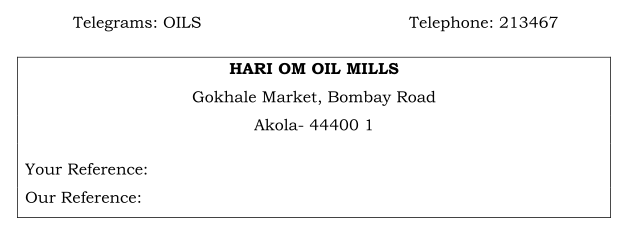
If yours is a reply letter, give the correspondent’s reference number against the first and your reference number against the second line. Some companies prefer to indicate the reference number of the correspondent in the body of letters:
Thank you for your Letter No. AB/46/P497 of August 2, 2001.
The first method is more advantageous as the number displayed at the top enables the receiving company to put your letter quickly into the proper file for action and this leads to saving of time. The reference number of the organization you are writing to should be written exactly as indicated in its letter.
The small and capital letters and the punctuation marks should be reproduced correctly. It would be annoying to the reader to waste his time looking for the proper file where the reference number was incorrectly reproduced.
Inside Address
The full address of the person or organization you are addressing should be written two spaces below the date arid two spaces above the attention line, or if there is no attention line, two spaces above the salutation in the left margin. The names of persons, firms, streets, roads, etc. should be written as indicated in the source you got the address from. These details should not be abbreviated.
For example, if you are writing to Sri Girdhari Lal Kadam, do not write his name as ‘Sri G.L. Kadam’ or ‘Sri Girdhari L. Kadam’ or ‘Sri G. Lal Kadam’. It is bad business manners to do so. Special care should be taken to spell the address’s name correctly. Misspelling his name may give him the impression that you have little respect for him.
In such circumstances, the best thing would be to write to the concerned officer of the company. If you do not know which officer should be addressed, write to the secretary because each company is required by law to have one:
| The Chief Accounts Officer Gannga Airways Limited Vikas Marg New Delhi-110091 |
In a letter addressed to an officer by name, write ‘Sri’ (abbreviated form of Sriman) before his name. If the officer is an unmarried woman add ‘Kum.’ (abbreviated form of Kumari) and if married ‘Smt.’ (shortened form of Srimati), before her name. In the case of a married woman, Smt. is followed by her name and the husband’s surname, e.g:
| Sri D.P. Dubey Kum. Sheila Goyal Smt. Nirmala Rani Goyal |
Attention Line
To ensure attention, sometimes a letter that is addressed to a firm or company is marked to the particular officer (either by designation or name) in that organization. This is done by writing an attention line two spaces below the inside addressed and two spaces above the salutation. The attention line is generally underlined:
| Attention: The Sales Manager Attention: Sri A.B. Nair |
Salutation
The salutation in a letter, an essential ingredient, is like greeting a person when you meet him. It is placed two spaces below the attention line or if there is no such line, two spaces below the inside address. The choice of salutation depends upon the personal relationship between the writer and the reader, and on the form of the inside address.
If you are addressing a firm, a board, a club, a society and association, an agency, or a post box or newspaper box number use ‘Dear Sirs’. Remember that the attention line does not alter the salutation. While writing to an officer by designation, write ‘Dear Sir’ or ‘Dear Madam’, as the case may be.
If you write a letter to an officer by name the salutation will be ‘Dear Sir’, ‘Dear Smt.’ or ‘Dear Kum.’ followed by his or her surname. If he or she does not write any surname; use the second part of the name after the salutation:
| Dear Sri Mazumdar Dear Smt. Gupta Dear Kum. Ramaswamy Dear Sri Lal |
If the correspondent is a close friend of yours, you may address him or her by the first name:
| My dear Hari Dear Tribhuwan My dear Sheihi Dear Ismat |
In government departments, letters that are addressed by name are known as demi-official letters. (D.O.). They are written to draw the personal attention of the concerned officer and to ensure prompt action. Sometimes sales and circular letters are addressed as ‘Dear Customer, ‘Dear Member’, ‘Dear Reader’, ‘Dear Subscriber’, etc.
Subject
The purpose of the subject line is to let the reader know immediately what the message is about. Like attention and reference lines, it saves time. If the letter has to be passed on to some other officer or department, it can be done quickly. The usual practice is to type this line in a double space between the salutation and the first line of the body of the letter. There are, however, some organizations that prefer to have the subject line between the attention line and the salutation. An example of both is given below:
| The Jindal Steel Corporation 443, Gokhale Street Karimnagar- 361 001 Attention: Sri P.R. Shindy Subject: Payment of Bill No. P/843 of 14 August, 2001 Dear Sirs, |
Some organizations do not write the word ‘subject’ but this has not yet caught on in India. The subject must be mentioned if it has been indicated in the letter you are replying to. If you are initiating the correspondence, it would be advisable to write it if you think that a number of letters will be exchanged on the subject.
Body
Primarily a letter is to convey a message and the main purpose of the message is to produce a suitable response in the reader. This is done mainly through the body of the letter. It is, therefore, important to organize and arrange the material very carefully. The qualities of an effective letter have already been discussed. What is said there applies to this part of the letter.
In the paragraph, reference, to any correspondence which has already taken place should be given and in the second the main message should be stated. The paragraphs that follow should contain further details, if necessary.
In the closing paragraph, you must state clearly what action you expect the reader to take, or you may end the letter indicating your expectations, wishes, or intentions. The paragraphs are not given any headings unless the letter is very long and deals with several important points.
Participial endings sound very trite and should be avoided as far as possible. If, however, you, close your letter with a phrase containing a present participle e.g., ‘Hoping to hear from you soon, you should add ‘I am as shown below:
| Hoping to hear from you soon, I am Yours faithfully, R. Narayanan |
Complimentary Close
The complimentary close is a courteous leave taking-a polite way of ending a letter. It is typed two spaces below the last line of the body of the letter. The close must agree with the salutation as shown below:
| Salutation | Complimentary Close | |
| 1. | Sir, | Yours faithfully, or Yours obediently, |
| 2. | Dear Sirs, Dear Sir, Dear Madams, Dear Madam, |
Yours respectfully, Yours faithfully, |
| 3. | Dear Sri Nayar, Dear Smt Sobti, Dear Kum. Lowal, My dear Sri Dheer, My dear Smt. Das My dear Kum. Nigam, |
Yours truly, Yours sincerely, |
| 4. | Dear Shyam, My dear Ashutosh, Dear Lata, My dear Sheila, |
Yours sincerely, Yours ever, |
| 5. | Dear Member, Dear Customer, Dear Reader, Dear Subscriber, |
Yours sincerely, |
In (i) above obediently is used when, for example, a student writes to his teacher. Respectfully is rarely used in business correspondence. However, it may be used by an individual in writing to a high dignitary.
Signature
The signature is the signed name of the writer. It is placed below the complimentary close. The name of the writer has generally typed four spaces below the dosing line, providing enough space for the signature:
|
Yours faithfully, (S.D. Vikash) |
For a partnership firm, any one of the partners may sign either by writing in ink the name of the firm or by putting his signature below the typed name of the firm.
In the case of registered or incorporated companies, the company responsibility line mayor may not be there. Important officers of a company, such as the Managing Director, Manager, Secretary, Financial Controller, and Chief Engineer, have the authority to sign letters on behalf of the company.
This authority may be the result of the execution of the Power of Attorney in their favor or as allowed by custom. Legal authority is indicated as in the case of partnership firms by adding Per pro before the name of the company.
Since the name of the company is given on the letterhead, it needs before the name of the company. Since the name of the company is given on the letterhead, it need not be repeated signature. Thus an officer of a company may sign in either of the following ways and in all these cases he will be binding the company legally.
| Yours faithfully, Yours faithfully, Narain Dass on behalf of SMITH INDIA LIMITED Managing Director Narain Dass Managing Director |
Enclosure
If there is anything attached to the letter, it must be indicated against the enclosure line which is typed two spaces below the identification marks. Generally, the abbreviated form Encl. is typed against which the number of enclosures is indicated:
Encl. 2
If, however, the documents attached are important they are specified:
Encls: 1. Agreement dated 1 September 2022
Cheque No. P4637 of 4 September; 2022
Read More Related Articles
[su_spoiler title=”What is Communication? | Mass Communication” style=”fancy” icon=”plus-circle”]
What is Communication?
[/su_spoiler]
[su_spoiler title=”Types of Communication | Principles of Communication” style=”fancy” icon=”plus-circle”]
-
Types of Communication
- Verbal Communication
- Non-Verbal Communication
- Written Communication
- Visual Communication
- Feedback Communication
- Mass Communication
- Group Communication
[/su_spoiler]
[su_spoiler title=”Nonverbal Communication | Verbal Communication” style=”fancy” icon=”plus-circle”]
[/su_spoiler]
[su_spoiler title=”Written Communication | Oral Communication” style=”fancy” icon=”plus-circle”]
Written Communication
[/su_spoiler]
[su_spoiler title=”Business Communication | Organizational Communication” style=”fancy” icon=”plus-circle”]
[/su_spoiler]
[su_spoiler title=”Formal Communication | Informal Communication” style=”fancy” icon=”plus-circle”]
[/su_spoiler]
[su_spoiler title=”Interpersonal Communication | Informal Communication” style=”fancy” icon=”plus-circle”]
[/su_spoiler]
[su_spoiler title=”Downward Communication | Upward Communication” style=”fancy” icon=”plus-circle”]
[/su_spoiler]
[su_spoiler title=”Barriers to Communication | Horizontal or Lateral Communication” style=”fancy” icon=”plus-circle”]
[/su_spoiler]
[su_spoiler title=”Self Development | Effective Communication” style=”fancy” icon=”plus-circle”]
[/su_spoiler]
[su_spoiler title=”Difference Between Oral and Written Communication | Theories of Communication” style=”fancy” icon=”plus-circle”]
[/su_spoiler]
What is letter writing?
Following is the letter writing Personal Letters, Business Letters, etc.
What are the principles of a business letter?
Principles of Business Letter:
1. Clarity and Coherence
2. Consideration
3. Brevity
4. Courtesy and Friendliness
5. Conciseness
6. Correctness
7. Completeness
8. Originality
9. Neatness
10. Effectiveness.
What are the main elements of the letter?
These are the main elements of a letter:
1. Heading
2. Date
3. Reference
4. Inside Address
5. Attention Line
6. Salutation
7. Subject
8. Body
9. Complimentary Close
10. Signature
11. Enclosure.


